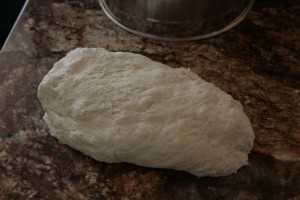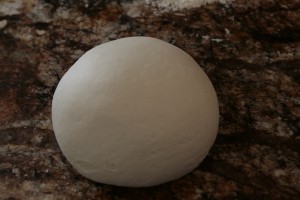Recipe: Neapolitan Pizza Dough
Note from Peter: I’ve been receiving a lot of requests for a proper VPN Napoletana dough. I’ve posted this previously on the Forno Bravo site, but wanted to be sure I also made it available here on PizzaQuest — especially in light of Brad’s recent post on making Margherita pizzas in two different ovens. Enjoy!!
A true Naples dough uses only flour, water, salt, and yeast. Some versions substitute sourdough starter for the yeast and some use a combination of both commercial yeast and natural starter. But this version is for yeast only (I recommend instant yeast). Also, it is customarily made with Italian -00- flour, of which there are a few brands available. Caputo is the most well known brand but now there are also American brands, such as King Arthur and Central Milling, who make their own version of this flour. Double Zero (-00-) means that it has been sifted fully to leave behind only the pure endosperm of the wheat, and typically uses a somewhat softer wheat than what we know as bread flour — more like all purpose flour, mixed with a little pastry flour, so that the gluten content is closer to 9.5% to 10%. But even this may vary because -00- doesn’t really refer to gluten, just to the purity of the grind and sifting. For this reason, any recipe can only give an approximation of the water content, depending on which brand of flour you use. You will have to adjust when you make it based on the feel of the dough. It shouldn’t be sticky, but it should be very supple and also tacky to the touch. The following recipe is based on the one from American Pie: My Search for the Perfect Pizza (Ten Speed Press, 2003). It will make five 8-ounce doughs (227 g), or six 6-ounce doughs (170 g).
5 cups unbleached all purpose or -00- flour (22.5 oz / 638 g)
1 3/4 teaspoons table salt (0.43 oz / 12.5 g) (if using coarse kosher salt it will be closer to 2 teaspoons)
1 teaspoon instant yeast (0.11 oz / 3 g)
1 3/4 cups plus 2 tablespoons cool water, 65º F (15 oz / 425 g)
- Mix all the ingredients together in a large bowl or an electric mixer on slow speed (use the paddle attachment) for about 1 minute. Let the dough rest for 5 minutes. If using a mixer, switch to the dough hook, then continue mixing on second speed for about 2 to 4 minutes, or until the dough is smooth and supple. Add flour or water if needed.
- Transfer the dough to a slightly oiled work surface and hand knead for an additional minute, making any final adjustments. The dough should be tacky but not sticky and feel very supple, not stiff. Cover the dough with a bowl and let it rest for 30 minutes.
- Divide the dough into desired size pieces and form each piece into a ball. Place the dough balls onto a lightly oiled pan or into a dough box. Mist with pan spray and cover with plastic wrap, a large plastic bag or trash can liner, or a lid. Place the pan into a refrigerator to slowly ferment overnight. (Note: if making pizza on the same day, allow at least 6 to 8 hours in the fridge). They will keep in the refrigerator for up to three days. (You can also refrigerate the whole dough, in a covered bowl or container, and divide and ball it the next day, two hours before you plan to make the pizzas).
- Remove the dough balls from the refrigerator 2 hours before you plan to bake the pizza to take off the chill and make them easier to stretch. (Note: You can also freeze the dough balls by placing them each in their own freezer zip bag that has been misted with spray oil. They will keep for up to three months. Move them to the refrigerator the day before you plan to make the pizzas to slowly thaw, then treat them as refrigerated dough the next day).
After that it’s all about the pizzas. Crank your home oven up as hot as it will go, preheat the baking stone for at least 45-60 minutes, and make your favorite version of Margherita or any Napoletana pizza.
We’d love to get your comments on this (below) as well as any photos you’d like to share. Send the photos to us at info@pizzaquest.com and we’ll add them to our media library and post the best ones.
May your pizzas all be perfect!!!
Peter
Recent Articles by Peter Reinhart
- “Tommy & Atticus” in Redondo Beach, CA. A Sourdough Success Story
- Howard Brownstein on Turnaround and Crisis Management
- Randy Clemens and Forest Farming in Uruguay — The Back to The Earth Movement is Back!
- It’s not too late to chase your dreams: “Pizza From the Heart” A New Book by Paulie and Mary Ann Gee
- Kyle Ahlgren on the Artisan Baking Center Online Classes (and a special offer)
- Multi-James Beard Nominee Cathy Whims of Portland’s Nostrana and her Brand New Book
Add Comment
You must be logged in to post a comment.














Confused about water temperature. The recipe says cool water 65 degrees. The package of yeast says very warm 120-130 degrees. There seems to be a lot of opinions on this. What is the difference in using warm vs. cold water
With cooler water you have more control over the fermentation and can extend it longer. The only time I use warm water is for active dry yeast, which needs to be dissolved and awakened for a few minutes, but instant yeast doesn’t need the water to be warm.
whats your opinion on using 100% natural starter and the type of flour / ferment time required?
Natural starter is wonderful if you’re comfortable using it. The answer to the rest of your question is too long to answer here but I suggest you look into Teresa Greenway’s website http://www.northwestsourdough.com She provides lots of ree info as well as very affordable e-books and videos. Also, Richard Miscovich’s Pizza class on Craftsy.com might have soe very useful ideas for you.
Hey, I love this recipe, and have been using it for months for a home electric pizza oven.
I’d like to step up the game a bit, a try it with sourdough. Do you have any recommendations on the amount of sourdough started instead of the yeast?
Regards,
Marian
I was wondering if there’s a specific temperature to cook this pizza at or should I just use the highest temperature my oven is set to? I was also wondering if halving this recipe changes the fermentation time at all.